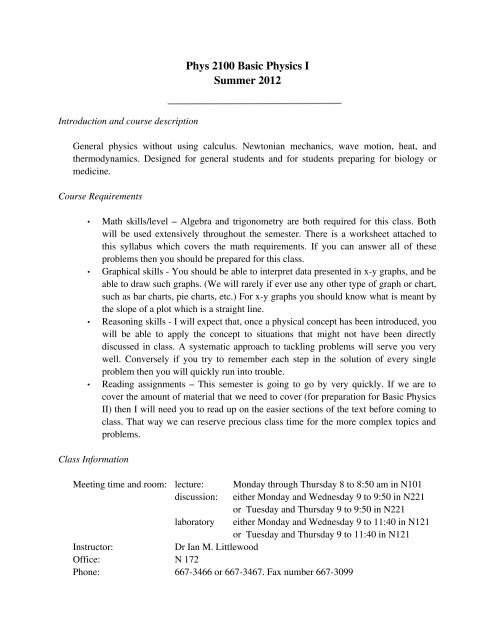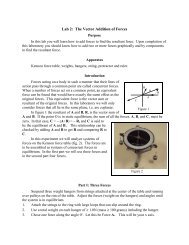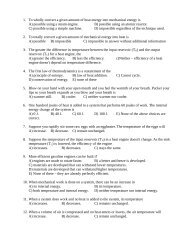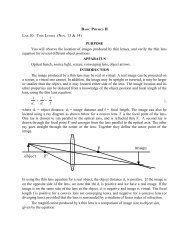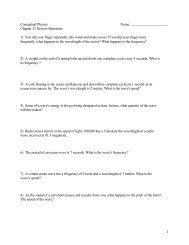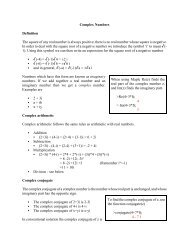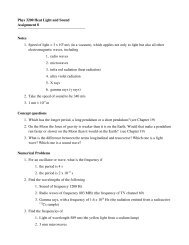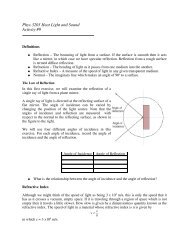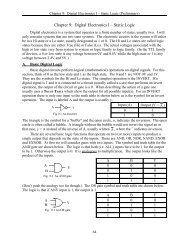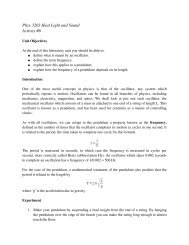syllabus - Physics @ CSU Stanislaus
syllabus - Physics @ CSU Stanislaus
syllabus - Physics @ CSU Stanislaus
You also want an ePaper? Increase the reach of your titles
YUMPU automatically turns print PDFs into web optimized ePapers that Google loves.
Phys 2100 Basic <strong>Physics</strong> I<br />
Summer 2012<br />
Introduction and course description<br />
General physics without using calculus. Newtonian mechanics, wave motion, heat, and<br />
thermodynamics. Designed for general students and for students preparing for biology or<br />
medicine.<br />
Course Requirements<br />
• Math skills/level – Algebra and trigonometry are both required for this class. Both<br />
will be used extensively throughout the semester. There is a worksheet attached to<br />
this <strong>syllabus</strong> which covers the math requirements. If you can answer all of these<br />
problems then you should be prepared for this class.<br />
• Graphical skills - You should be able to interpret data presented in x-y graphs, and be<br />
able to draw such graphs. (We will rarely if ever use any other type of graph or chart,<br />
such as bar charts, pie charts, etc.) For x-y graphs you should know what is meant by<br />
the slope of a plot which is a straight line.<br />
• Reasoning skills - I will expect that, once a physical concept has been introduced, you<br />
will be able to apply the concept to situations that might not have been directly<br />
discussed in class. A systematic approach to tackling problems will serve you very<br />
well. Conversely if you try to remember each step in the solution of every single<br />
problem then you will quickly run into trouble.<br />
• Reading assignments – This semester is going to go by very quickly. If we are to<br />
cover the amount of material that we need to cover (for preparation for Basic <strong>Physics</strong><br />
II) then I will need you to read up on the easier sections of the text before coming to<br />
class. That way we can reserve precious class time for the more complex topics and<br />
problems.<br />
Class Information<br />
Meeting time and room: lecture: Monday through Thursday 8 to 8:50 am in N101<br />
discussion: either Monday and Wednesday 9 to 9:50 in N221<br />
or Tuesday and Thursday 9 to 9:50 in N221<br />
laboratory either Monday and Wednesday 9 to 11:40 in N121<br />
or Tuesday and Thursday 9 to 11:40 in N121<br />
Instructor:<br />
Dr Ian M. Littlewood<br />
Office: N 172<br />
Phone: 667-3466 or 667-3467. Fax number 667-3099
Email<br />
ian@physics.csustan.edu<br />
Office Hours MT 10:00 to 12:00 in N 172<br />
Web Site:<br />
http://physics.csustan.edu<br />
Text:<br />
“<strong>Physics</strong>” by Giancoli<br />
Grading<br />
Grading Percentages<br />
Test Dates<br />
Homework 15% 1 st Midterm June 14 th<br />
Class Tests 50% 2 nd Midterm June 28 th<br />
Final Exam 20% 3 rd Midterm July 12 th<br />
Laboratories 15% Final Exam July 26 th<br />
Total 100%<br />
Exams<br />
Letter grades will be determined from a curve using the final scores. I will not be using a +/-<br />
grading scheme.<br />
There will be three one hour exams on alternate Thursdays, and a 2 hour final exam on<br />
the last Thursday of the semester (dates above). In order to preserve precious class time<br />
the exams will be held during the period 9 am to 10 am (midterms) and 9 am to 11 am<br />
(final). If you have a discussion session on Thursdays at 9 am then you will take the exam<br />
in room N221. If you have a lab section on Thursdays at 9 am then you will take the<br />
exam in room N121. Note: there will not be a laboratory on either the Wednesday or<br />
Thursday for those weeks when there is an exam. A discussion section will be held<br />
instead during the Wednesday lab section.<br />
Tips for success<br />
• Keep up with the reading and problem assignments. Fall behind in this short semester and<br />
you will find it very difficult to catch up.<br />
• Don't memorize the solutions to problems, learn how to solve them. Once you have<br />
mastered the techniques they can be applied to any relevant problem.<br />
• Be methodical. Constantly changing approaches only leads to chaos.<br />
• Study groups. You will learn a lot from each other, providing everyone contributes.<br />
Simply copying from the “brightest” person in the group will do you no good at all. (I<br />
will let you turn in a homework assignment as a group.)
Note on units<br />
In this class we will be using the rationalized SI units (or MKSA units). In this convention<br />
the correct units are<br />
• Base units<br />
• for distance - meter (m). A meter is a little over 3 feet, and there are roughly 1600<br />
m to the mile<br />
• for time - second (s)<br />
• for mass - kilogram (kg). A 1 kg loaf of bread would be about 2.2 lbs. The mass<br />
of an average adult is around 75 kg, and the mass of a car in the range 1000 to<br />
3000 kg.<br />
• for electrical current - ampere (A)<br />
• Derived or composite units, which are combination of the above four base units<br />
• for example the unit of energy is the Joule (J) where 1 J = 1 kg m²/s²<br />
Some numbers are particularly large or small. It is common to use prefixes to units to avoid<br />
writing out long numbers with lots of zeroes. The prefixes we shall be using are<br />
• M = 1,000,000 = 10 6 (pronounced mega)<br />
• k = 1,000 = 10 3 (pronounced kilo)<br />
• m = 0.001 = 10 -3 (pronounced milli)<br />
• μ = 0.000001 = 10 -6 (pronounced micro)<br />
• n = 0.000000001 = 10 -9 (pronounced nano)<br />
Note on Answering Numerical Questions<br />
One of the most important goals of a university education is the ability to communicate. I<br />
interpret that to mean that you can communicate not only the correct answer but that you<br />
know what you are doing. You might for example imagine that you are writing a short report<br />
to your supervisor in a company. He is knowledgeable about the subject, but does not know<br />
the detailed information of the project that you are working on. Your report to him needs to<br />
tell him your conclusion, and enough to know that he can rely on your judgment when<br />
making business decisions.<br />
So, imagine that I ask the question “If I drive at 30 km/h for 20 minutes, how far do I go”<br />
Here are some possible responses
600 km<br />
10 km<br />
10,000 m<br />
Response<br />
time = 20 minutes = ⅓ hour<br />
distance = speed * time<br />
= 30 km/h * ⅓ hour<br />
= 10 km<br />
Comment<br />
On tests it is to your advantage to write out your calculation. If you make a mistake part way<br />
through then I will assign partial credit to the amount that you have correct. To a certain<br />
extent the same applies to homework assignment.<br />
Your final step in answering a numerical question is to ask if the answer looks right. You will<br />
often have a rough idea of the correct answer, and if your answer is outside the range of<br />
expected answers that is a good indication that you have made a mistake.
Mathematics Worksheet<br />
Try answering the following questions. If you can correctly solve all of them then you have the<br />
appropriate mathematical background for this class. You can find the answers by downloading<br />
this <strong>syllabus</strong> from the <strong>Physics</strong> Department website – http://physics.csustan.edu<br />
Algebra<br />
• Solve for x: a b x =c 2 Answer: x= b<br />
c−a<br />
• Solve for t: 3.6 t 2 9 t=50.75 Answer: either 2.71 or -5.21<br />
1<br />
• Solve for m:<br />
2 m v2 =2mMV 2 2<br />
m v o Answer: m=<br />
4M V2<br />
v 2 −4V 2 −2v o<br />
2<br />
• Solve for x and y: 2 x5y=9 and 6 x4=5y Answer: x=5/8 y=31/20<br />
Trigonometry<br />
• What is sin(45 o ) Answer: 1/√2 = 0.7071<br />
• What is cos(212 o ) Answer: -0.848<br />
• What is the principle value of tan -1 (0.6) Answer: 30.96 o Are there any other solutions<br />
Yes, you can add or subtract 180 o as many times as you like.<br />
1<br />
• Simplify −sintan Answer: cos(θ)<br />
cos


